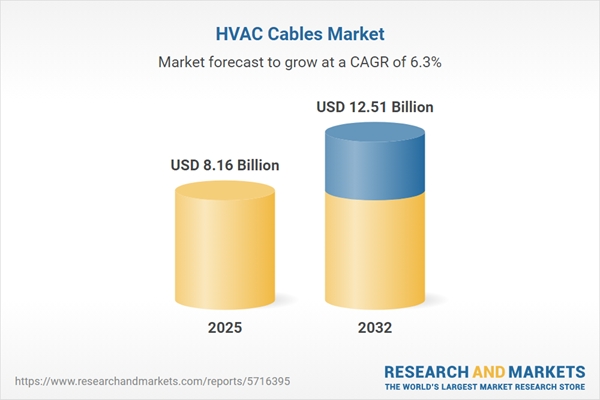Speak directly to the analyst to clarify any post sales queries you may have.
The HVAC cables market is evolving rapidly, driven by advances in material science, digital integration, and the demands of next-generation infrastructure. Senior decision-makers are navigating complex procurement challenges while also seeking resilient, efficient solutions that align with both regulatory and operational imperatives.
Market Snapshot: HVAC Cables Market Growth and Outlook
The HVAC cables market grew from USD 7.67 billion in 2024 to USD 8.16 billion in 2025. It is expected to continue expanding at a CAGR of 6.31%, reaching USD 12.51 billion by 2032. This upward trajectory is fueled by modernization initiatives, sustainability mandates, and growing infrastructure investments worldwide.
Scope & Segmentation
This report delivers comprehensive analysis on shifts shaping the HVAC cables ecosystem, market segmentation, and regional trends.
- Voltage Rating: High Voltage, Medium Voltage, Low Voltage
- Conductor Material: Copper, Aluminum, Alloy (including Nickel Alloy, Stainless Steel)
- Insulation Type: PVC, XLPE, Rubber (EPDM, Silicone)
- Application: Commercial (Hospitality, Office, Retail), Industrial (Data Center, Manufacturing, Process Cooling), Residential (Single Family, Multi Family)
- Product Type: Mineral Insulated, Fiberglass Inconel, Thermocouple (Type J, Type K, Type T)
- Regions Analyzed: Americas (United States, Canada, Mexico, Brazil, Argentina, Chile, Colombia, Peru), Europe, Middle East & Africa (UK, Germany, France, Russia, Italy, Spain, Netherlands, Sweden, Poland, Switzerland, UAE, Saudi Arabia, Qatar, Turkey, Israel, South Africa, Nigeria, Egypt, Kenya), Asia-Pacific (China, India, Japan, Australia, South Korea, Indonesia, Thailand, Malaysia, Singapore, Taiwan)
- Key Companies Covered: Prysmian S.p.A., Nexans S.A., Sumitomo Electric Industries, Ltd., LS Cable & System Ltd., Furukawa Electric Co., Ltd., Southwire Company, LLC, Belden Inc., Encore Wire Corporation, Superior Essex Inc., NKT A/S
Key Takeaways for Senior Decision-Makers
- Material innovation, including advanced alloys and insulation compounds, is reshaping reliability and longevity in HVAC cable deployments.
- Adoption of digital monitoring, such as embedded sensors and diagnostics, supports predictive maintenance, enabling reduced downtime and proactive asset management.
- Sustainability goals, such as carbon neutrality and resource stewardship, are accelerating shifts to recyclable and low-impact product designs across commercial, industrial, and residential segments.
- Regional variations create unique opportunities, with Americas focusing on grid resilience, EMEA aligning with strict safety and environmental mandates, and Asia-Pacific driving versatile solutions for rapid electrification and urbanization.
- Suppliers are responding to total cost of ownership considerations by developing modular architectures and plug-and-play connectors that simplify installation and retrofit projects.
- Increasing competition is extending beyond performance excellence to include value-added services such as lifecycle analytics, technical training, and expedited delivery.
Tariff Impact on HVAC Cables Market
Recent changes to the U.S. tariff regime have notably shifted procurement strategies. Adjusted duty rates on imported materials and assemblies have resulted in more favorable conditions for domestic producers, but also heighten pressure on raw material supply chains. To manage increased costs, stakeholders are optimizing sourcing models—blending domestic and international components—and forming strategic alliances to stabilize input pricing and comply with new trade requirements. These adjustments demand agile supply chain management and robust tariff mitigation approaches for long-term competitiveness.
Methodology & Data Sources
The research for this report combines exhaustive secondary analysis of technical standards, regulatory documents, and industry white papers with primary interviews from sector leaders. Quantitative surveys capture adoption rates, while expert panels provide validation and refine insights on evolving conductor and insulation technologies. All findings benefit from multi-layer peer review to guarantee accuracy and reliability.
Why This Report Matters
- Enables informed capital planning and targeted sourcing, supporting strategic decision-making in a dynamically regulated context.
- Identifies emerging opportunities by mapping technology adoption curves, regional demand, and supplier differentiation strategies.
- Offers actionable recommendations for improving system resilience, cost efficiency, and sustainability compliance in HVAC cable networks.
Conclusion
The HVAC cables market is responding to global transformation with innovations spanning material science, digitization, and adaptive supply models. Organizations positioned for success will integrate new technologies and flexible sourcing to optimize performance and resilience across diverse infrastructure projects.
Additional Product Information:
- Purchase of this report includes 1 year online access with quarterly updates.
- This report can be updated on request. Please contact our Customer Experience team using the Ask a Question widget on our website.
Table of Contents
3. Executive Summary
4. Market Overview
7. Cumulative Impact of Artificial Intelligence 2025
Companies Mentioned
The companies profiled in this HVAC Cables market report include:- Prysmian S.p.A.
- Nexans S.A.
- Sumitomo Electric Industries, Ltd.
- LS Cable & System Ltd.
- Furukawa Electric Co., Ltd.
- Southwire Company, LLC
- Belden Inc.
- Encore Wire Corporation
- Superior Essex Inc.
- NKT A/S
Table Information
| Report Attribute | Details |
|---|---|
| No. of Pages | 193 |
| Published | October 2025 |
| Forecast Period | 2025 - 2032 |
| Estimated Market Value ( USD | $ 8.16 Billion |
| Forecasted Market Value ( USD | $ 12.51 Billion |
| Compound Annual Growth Rate | 6.3% |
| Regions Covered | Global |
| No. of Companies Mentioned | 11 |









